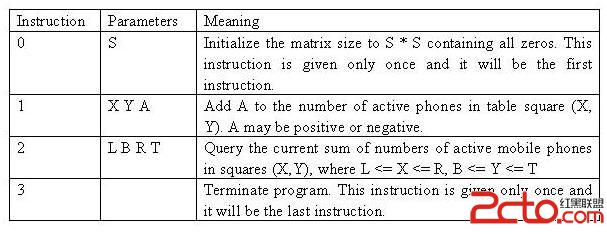Description
Suppose that the fourth generation mobile phone base stations in the Tampere area operate as follows. The area is divided into squares. The squares form an S * S matrix with the rows and columns numbered from 0 to S-1. Each square contains a base station. The number of active mobile phones inside a square can change because a phone is moved from a square to another or a phone is switched on or off. At times, each base station reports the change in the number of active phones to the main base station along with the row and the column of the matrix.Input
The input is read from standard input as integers and the answers to the queries are written to standard output as integers. The input is encoded as follows. Each input comes on a separate line, and consists of one instruction integer and a number of parameter integers according to the following table.
Output
Your program should not answer anything to lines with an instruction other than 2. If the instruction is 2, then your program is expected to answer the query by writing the answer as a single line containing a single integer to standard output.Sample Input
0 4 1 1 2 3 2 0 0 2 2 1 1 1 2 1 1 2 -1 2 1 1 2 3 3
Sample Output
3 4
Source
IOI 2001#include#include #include #include #include using namespace std; const int maxn = 1025; int n,id; int c[maxn][maxn]; int lowbit(int x) { return x&(-x); } void updata(int i,int j,int k) { while(i<=n) { int pj = j; while(pj<=n) { c[i][pj] += k; pj += lowbit(pj); } i += lowbit(i); } } int getsum(int i,int j) { int sum = 0; while(i>0) { int pj = j; while(pj>0) { sum += c[i][pj]; pj -= lowbit(pj); } i -= lowbit(i); } return sum; } int main() { scanf("%d%d",&id,&n); int x,y,z,xx,yy; while(scanf("%d",&id)!=EOF) { if(id == 3) { break; } if(id == 1) { scanf("%d%d%d",&x,&y,&z); x++; y++; updata(x,y,z); } else if(id == 2) { scanf("%d%d%d%d",&x,&y,&xx,&yy); x++; y++; xx++; yy++; printf("%d\n",getsum(xx,yy)-getsum(x-1,yy) - getsum(xx,y-1) + getsum(x-1,y-1)); } } return 0; }